 |
|
 |
|
updated to follow: Stratigraphic Guide to the Cromer Knoll, Shetland and Chalk Groups of the North Sea and Norwegian Sea. Felix M. Gradstein & Colin C. Waters (editors), Mike Charnock, Dirk Munsterman, Michelle Hollerbach, Harald Brunstad, Øyvind Hammer & Luis Vergara (contributors). Newsletter on Stratigraphy, vol 49/1 pp71-280, 2016
Shetland Group, Springar Formation
The Hvithval Member is a member of the Springar Formation, as found in the Vøring Basin. It has been drilled in wells on the structurally high areas of the Gjallar Ridge, e.g. 6704/12-1 and Nyk High e.g. 6707/10-1. The member consists of sandstones with subordinate, interbedded mudstones and siltstones.
The member is assigned a Late Cretaceous, late Campanian - Maastrichtian age.
Derivatio nominis: The name Hvithval is the Norwegian name for the white whale or Beluga species Delphinapterus leucas. The species is a toothed whale species of moderately large size (reaching up to 4.5m long) that are found in small schools or flocks in Arctic seas such as the Polar Sea around Svalbard and in the Barents Sea.
The Hvithval Member consists of sandstones with subordinate, interbedded mudstones and siltstones, and with rare limestone and dolomite stringers.
The sandstones are white - yellow light grey, medium grey - medium dark grey to light brown grey, clear quartz grains, transparent to translucent, colourless, white to pink, very hard, loose, very fine to coarse, predominantly fine to medium, occasionally very coarse, angular to rounded, generally sub-angular to sub-rounded, poorly to moderately sorted, well cemented, siliceous cement with occasional calcite cement, argillaceous, silty, occasionally pyritic, glauconitic, chloritic, micaceous, trace of carbonaceous material, with no or poor visible porosity, occasionally grading to siltstone.
The subordinate mudstones are light - medium grey to brown grey, predominantly firm, occasionally soft to moderately hard, amorphous to blocky or sub-fissile, with disseminated and nodular pyrite, glauconitic, micaceous, silty, sandy, occasionally very sandy, and moderately calcareous with occasional dark laminae.
The siltstones (developed particularly in the lower part of the member), are light to medium grey, soft to firm, friable, argillaceous matrix, disseminated pyrite, arenaceous with very fine to fine sand, micaceous, glauconitic, non to moderately calcareous.
The infrequent limestone stringers are white- very light grey to medium dark grey- brown grey, firm, microcrystalline, silty, occasionally sandy with traces of glauconite and micro- mica.
The dolomite stringers are white to very light grey, firm to moderately hard and blocky.
Reference well 6707/10-1: 4 slides from ditch cuttings covering the interval 2230m - 2410m deposited at the NPD (DONG preparations).
This represents the uppermost part of the member and includes the unconformable upper boundary with the overlying Rogaland Group. The boundary is not readily identifiable in spite of being an unconformity. The boundary is a sand/sand contact and in addition to the marked difference in age, the overlying basal Tang Formation is characterised by glauconitic sandstones seen at the top of core #1 between 2554m and 2555.1 m (uncorrected measured depth). The core shift is -2.3m.
Reference well 6707/10-1: no core was taken in this member.
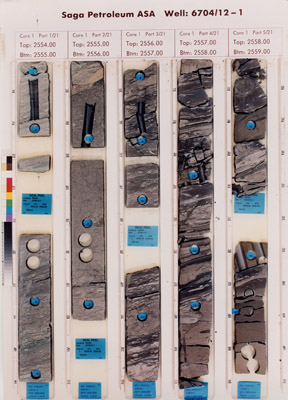 6704/12-1, 2554-2559 m |
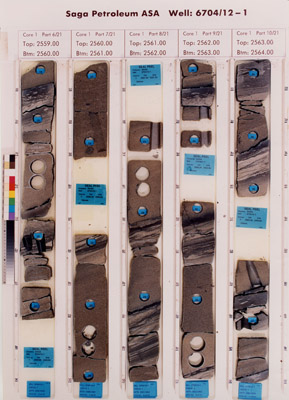 6704/12-1, 2559-2564 m |
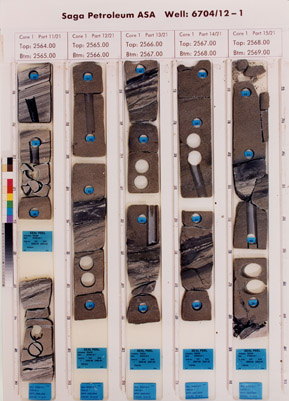 6704/12-1, 2564-2569 m |
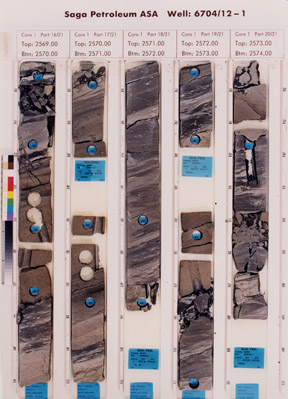 6704/12-1, 2569-2574 m |
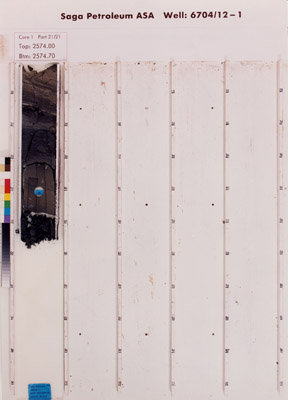 6704/12-1, 2574-2575 m |
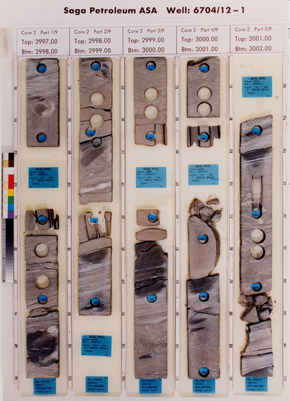 6704/12-1, 2997-3002 m |
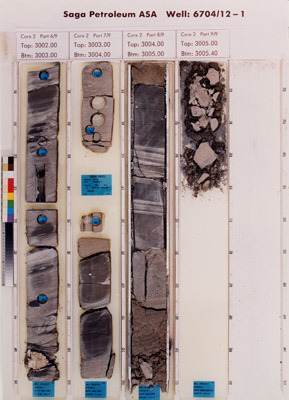 6704/12-1, 3002-3005 m |
Well name: 6704/12-1
WGS84 coordinates: N 67°07'25.00, E 04°42'44.70
UTM coordinates: 7446374.14 N 574282.36 E
UTM zone: 31
Drilling operator name: Saga Petroleum ASA
Completion date: 24.07.1999
Status: P & A
Interval of type section (m) & thickness in type well (m):
3244m - 2552.7m (2555.1m MD core depth) and 691.3m thickness.
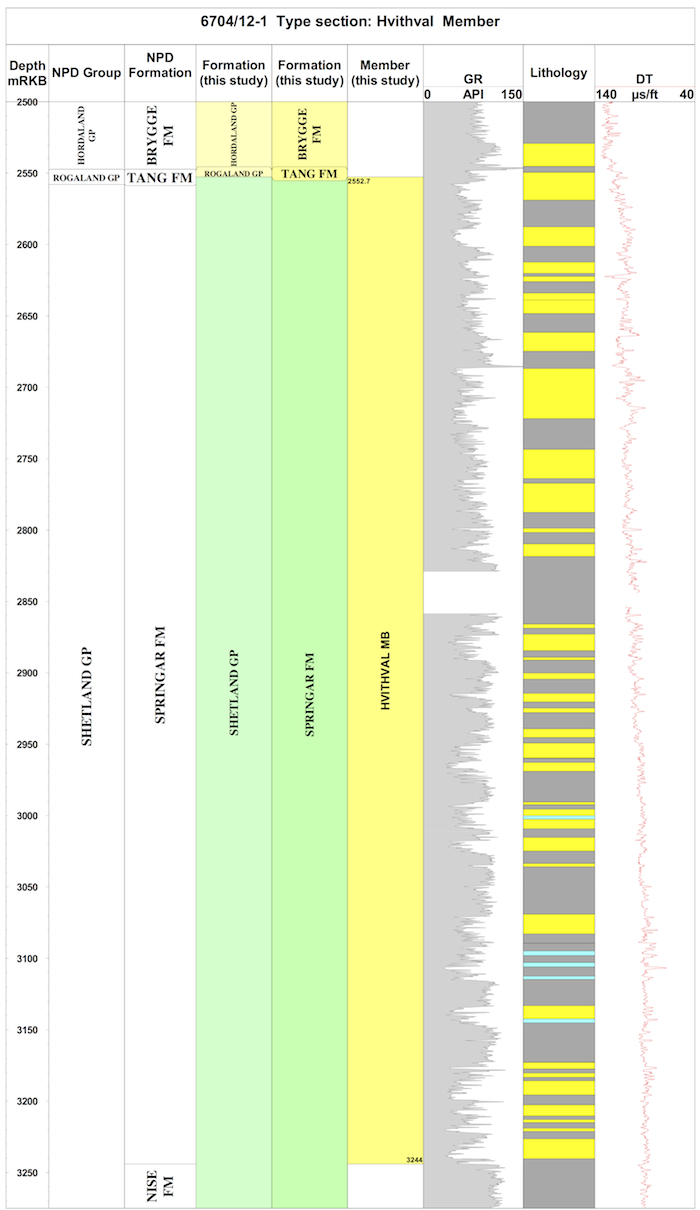
Click for large version (PDF)
Well name: 6707/10-1
WGS84 coordinates: N 67°04'07.85, E 07°00'36.51
UTM coordinates: 7440629.70 N 413490.42 E
UTM zone: 32
Drilling operator name: BP Norway Ltd
Completion date: 23.07.1997
Status: P & A
Interval of reference section (m) & thickness in reference well (m):
2434m - 2213m and 221m thickness.
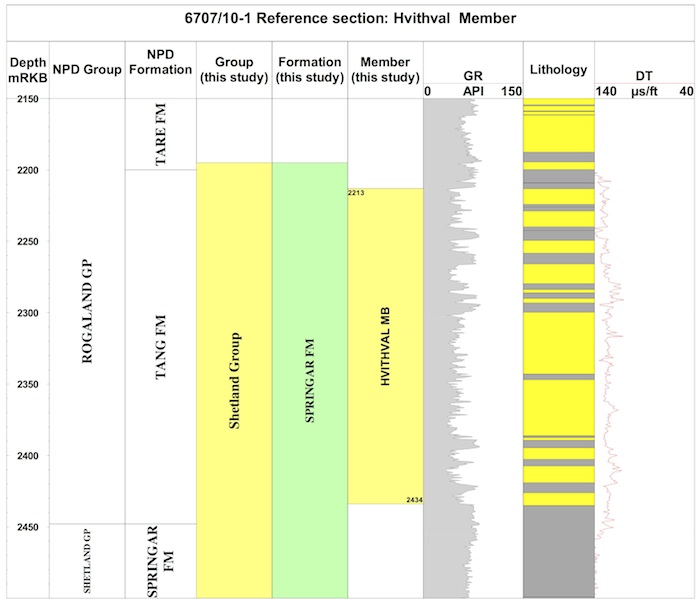
Click for large version (PDF)
In the type well 6704/12-1, the top of the Hvithval Member is poorly defined in core although it represents the unconformable K/C boundary with the overlying Upper Paleocene Tang sandstones (informal) at 2555.1mMD (2552.8m corrected core depth). The boundary, therefore, represents a contact between two sandstones units of significantly different age separated by a stratigraphic break in the order of 10 m.y.
The thin sandstones of the Tang Formation are characterised by glauconitic and bioturbated sandstones. These sediments are interpreted as representing a relatively shallow marine transgressive lag deposit that unconformably overlies the deep marine sandstones of the Hvithval Member. This unconformity is represented on wireline logs by a minor downward decrease in gamma-ray values. The log signature may be related to the down-section decrease in glauconite content of the sandstones and an increase in sonic velocity.The base of the Hvithval Member is marked by the down section change from sandstones with interbedded mudstones to argillaceous sediments of the Springar Formation. It is marked on logs by a downward increase in gamma-ray values and a minor decrease in average sonic velocity. In the type well 6704/12-1, there is downward positive separation between neutron and density logs reflecting the down section development of mudstones but this is slightly above the gamma and sonic changes.
The dating of the Hvithval Member is complicated by reworking from older stratigraphic levels (a mixture ranging from Permo-Triassic to Maastrichtian ages) and probably intra- member recycling. The age is primarily based on dinoflagellate cysts.
In the basal part of the member in the Gjallar Ridge type well 6704/12-1, the LCO Odontochitina operculata, LO O. costata and LO O. 'wetzelii' Wilson 1974 suggest an age at least as old as early Maastrichtian. The occurrence of Palaeohystrichophora infusorioides is more typical of late Campanian. The LAO Heterosphaeridium heteracanthum in the underlying mudstones of the Nise Formation confirms a late Campanian age. In the Nyk High reference well 6707/10-1 the base of the Hvithval Member is slightly younger, being above the Odontochitina plexus.
The youngest extent of the member in the type well 6704/12-1 is early Maastrichtian, and developed below the LO Alterbidinium acutulum. In the reference well 6707/10-1, the upper part of the member is within the acme of Impagidium 'septentrionalis', indicating a slightly younger intra-late Maastrictian age.
In general, the Foraminifera assemblage is dominated by LO Caudammina ovula, LO Rzehakina epigona, LO Kalamopsis gryzybowskii and the planktonic taxon LO Heterohelix globulosa.
In the type well 6704/12-1 the upper boundary of the Hvithval Member is unconformable and coincides with the base of glauconite rich sandstones of the Tang Formation. This may be observed in core at 2555.1mMD (2552.7m corrected core depth). A stratigraphic break in the order of 10 m.y. is indicated. The overlying interval yields the Middle Paleocene dinocyst markers LO Isabelidinium viborgense, LO Palaeocystodinium bulliforme and LCO Palaeoperidinium pyrophorum.
Age
Late Cretaceous, late Campanian - late Maastrichtian, but mainly early Maastrichtian.Little is published on the depositional setting of the Hvithval Member.
The sandstones were deposited within a large scale, deep-water, distal basin floor fan (Fugelli and Olsen, 2005b) as part of their play 1 concept. Deposition was probably by mass flow, with the sediments originating from the north or north-westerly locations towards the Greenland mainland.
In their study of outcrop analogues, Fugelli and Olsen (2005a), considered the sand-rich fan complex of the Brushy Canyon Formation in the Delaware Basin, USA to be an analogous system.
In the mudstones mass of the member, the presence of agglutinated Foraminifera indicates upper to middle bathyal water depths, with oxygen restricted bottom conditions.
Fugelli, E. and Olsen T. R. 2005b. Risk assessment and play fairway analysis in frontier basins: Part 2 - Examples from offshore mid- Norway. AAPG Bulletin, 89(7), 883-896.
Færseth, R. and Lien, T. 2002. Cretaceous evolution in the Norwegian Sea - a period characterized by tectonic quiescence. Marine and Petroleum Geology, 19, 1005 -1027.
Lien, T. 2005. From Rifting to drifting: effects on the development of deep-water hydrocarbon reservoirs in a passive margin setting, Norwegian Sea. Norwegian Journal of Geology, 85 319-332.
Vergara, L., Wreglesworth, I., Trayfoot, M., Richardsen, G. 2001. The distribution of
Cretaceous and Paleocene deep-water reservoirs in the Norwegian Sea basins. Petroleum
Geoscience, 7, 395-408.
| home | previous page |